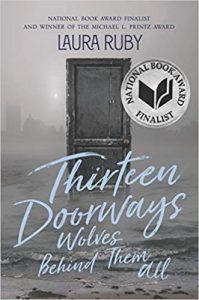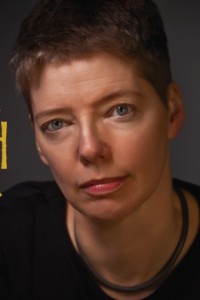2019 by Colleen Mondor

I read a lot of great young adult SF/F books in 2019 and was most struck by the diversity of subjects that came across my desk. There continues (thankfully) to be no dominant theme in YA fantasy, a welcome departure from the past. With the exception of a cluster of titles set in Paris (which is fine; what’s not to like about Paris?), it’s really impossible to point in any single direction for 2019 publishing trends. Here first is all the good, followed by what I hope 2020 will bring.
A few big series had some notable entries in 2019. The Queen of Nothing, the final volume in Holly Black’s Folk of the Air trilogy, dropped in November and gave Black’s legion of fans all the romance, violence, and political intrigue that those who have loved this foray into the dangers of Faerie could want. Black needs to prove nothing at this point – her bonafides as a force of nature in the fantasy world are cemented in the hearts of all those who read and love her books. But “Folk of the Air” takes her to a new level and its sophisticated plot and alluring romance combine to give readers something truly special.
L.L. McKinney continued to expand on her nightmare-laden version of Wonderland with the action-packed A Dream So Dark. Her Atlanta-based Alice is gifted with some outstanding supporting characters (I must single out the poetry-spouting Doormouse and smart-ass Russian Tweedle brothers), an indefatigable mother, and a host of complications both fantastic and otherwise. For Tomi Adeyemi, the next book in her “Legacy of Orisha” series is the recently released Children of Virtue and Vengeance. Now that Zélie and Amari have brought magic back to the land the fallout is… EPIC. The world-building continues to be stellar in this series and the plot brings a host of thrills. While McKinney proves that classic stories can be reimagined in brilliant ways, Adeyemi shows the wealth of stories that remain to be written. Kudos to both of these authors.
 Paris was home to some series debuts last year, including Gilded Wolves by Roshani Chokshi and Spectacle by Jodi Lynn Zdrok. These books could not be more different – Wolves is a dazzling mashup of Mission Impossible and Harry Potter (in the broadest of terms) that is marked by Chokshi’s glittering descriptions, gorgeous use of language, and a group of characters who should put all previously existing Scooby gang comparisons to rest. Meanwhile, Spectacle embraces a far more traditional version of Paris. Set in 1887, budding columnist Nathalie Baudin covers the morgue reporting on the latest bodies put on display for identification. (This really did happen.) Baudin’s world is turned upside down when she has a vision of a recent murder victim from the perspective of the person who killed her. What follows is a mystery that encompasses a bit of mad science and a whiff of romance, all while Baudin struggles to accept her “talent” and understand what it means. (Both of these series will see sequels in 2020.)
Paris was home to some series debuts last year, including Gilded Wolves by Roshani Chokshi and Spectacle by Jodi Lynn Zdrok. These books could not be more different – Wolves is a dazzling mashup of Mission Impossible and Harry Potter (in the broadest of terms) that is marked by Chokshi’s glittering descriptions, gorgeous use of language, and a group of characters who should put all previously existing Scooby gang comparisons to rest. Meanwhile, Spectacle embraces a far more traditional version of Paris. Set in 1887, budding columnist Nathalie Baudin covers the morgue reporting on the latest bodies put on display for identification. (This really did happen.) Baudin’s world is turned upside down when she has a vision of a recent murder victim from the perspective of the person who killed her. What follows is a mystery that encompasses a bit of mad science and a whiff of romance, all while Baudin struggles to accept her “talent” and understand what it means. (Both of these series will see sequels in 2020.)
A third Paris title is An Affair of Poisons by Addie Thorley which used an actual late 17th-century royal scandal as a springboard for a novel about alchemy, dragons, and an extraordinarily toxic mother/daughter relationship. The history is as beguiling as the magic in this novel, especially as it involves royal children whose true lives were cut tragically short. Thorley has so much fun here, mixing up truth and fantasy, that readers find themselves sucked into the plot with ease. Also, dragons. Enough said.
My standalone favorites were many and varied in 2019 and included everything from a fairy tale retelling to a Scottish riff on Peter Pan and a murder mystery set in Australia. There were also many ghosts in novels this year, such as that of a little boy killed in New York City’s 1863 Colored Orphans Asylum fire in Pat Cummings’s thoughtful contemporary, Trace. This novel has one of the best depictions of a family rebuilding itself after a tragic accident that I have ever read and the ghost from the past is a tender historical bonus. In The Things She’s Seen, Beth Teller, who was killed in a car crash, accompanies her police detective father as a ghost companion (he can see her) while he investigates a suspicious fire in a remote Australian town. The two of them stumble on a larger case involving murder and Australia’s tragic history of stolen Aborigine children. Sibling authors Ambelin & Ezekiel Kwaymullina bring a lot of heart to this lyrical novel which takes readers on a winding path that pays off in a powerful way.
 Laura Ruby hit it way out of the park with her latest, Thirteen Doorways, Wolves Behind Them All. Set during WWII, Doorways simultaneously tells the stories of Frankie, deposited with her siblings by their father in an orphanage after their mother dies (and then further abandoned when he marries again) and Pearl, a ghost among many haunting the city. How Pearl and Frankie come together, amid the unfolding of Pearl’s past and the daunting nature of Frankie’s future, makes for a twist-filled plot that Ruby unfolds with masterful writing. Definitely one of the best books I’ve read in ages.
Laura Ruby hit it way out of the park with her latest, Thirteen Doorways, Wolves Behind Them All. Set during WWII, Doorways simultaneously tells the stories of Frankie, deposited with her siblings by their father in an orphanage after their mother dies (and then further abandoned when he marries again) and Pearl, a ghost among many haunting the city. How Pearl and Frankie come together, amid the unfolding of Pearl’s past and the daunting nature of Frankie’s future, makes for a twist-filled plot that Ruby unfolds with masterful writing. Definitely one of the best books I’ve read in ages.
Lovely War by Julie Berry is also set during wartime, with the addition of Greek gods and goddesses to frame the WWI narrative. The opening chapter catches Aphrodite in a compromising position with Ares. To dodge a trial on Olympus, she tries to prove to her angry husband Hephaestus how traumatic her work with mortals can be. She relates four converging stories of the Great War, including occasional asides from several of the gods who serve as cameos in the four lives. Lovely War thus succeeds on two levels: as powerful historical fiction about the war, while providing a fresh look at the long under appreciated Aphrodite. The ending on this is also most satisfying, especially for those with a romantic heart.
Shifting to contemporary Scotland, Sophie Cameron shows just how enchanting a fantasyland can be with Last Bus to Everland. Nodding to everyone from Peter Pan to Narnia, she shows what it can mean when you don’t fit with the people who love you and seek out others to make you feel at home. Things don’t go in the direction readers might expect and the ending is just sublime (and shows just how far love will reach).
Sara Maria Griffin proves that terrifying things can and do live within the walls in Other Words for Smoke. (Spoiler alert – there is a tooth removal scene in this eerie novel that I am never going to forget!) In another spooky novel, Sara Faring transports readers from the familiar environs of a haunted house (or haunted school in this instance) to a… well, if I tell you I will spoil the ending, so let’s just say that The Tenth Girl spins this gothic thriller in a direction you will never expect and still has me marveling at how well the author pulled it off.
 There is plague, a murderous caste system, a prince who must be saved, his heroic bodyguard, and the much maligned Crow clan who possess a lot of unrealized power in Sarah Owen’s The Merciful Crow. As the story unfolds, all that power lands in the hands of a new young chieftain, and she is more than ready to unleash it on those who deserve to feel her wrath. Crow is the first in a new series, (second book due July 2020), and does a great job of blending magic, romance, and relentless plotting with first class worldbuilding. (As you are probably realizing by now, the worldbuilding in YA fantasy was off-the-charts outstanding in 2019.)
There is plague, a murderous caste system, a prince who must be saved, his heroic bodyguard, and the much maligned Crow clan who possess a lot of unrealized power in Sarah Owen’s The Merciful Crow. As the story unfolds, all that power lands in the hands of a new young chieftain, and she is more than ready to unleash it on those who deserve to feel her wrath. Crow is the first in a new series, (second book due July 2020), and does a great job of blending magic, romance, and relentless plotting with first class worldbuilding. (As you are probably realizing by now, the worldbuilding in YA fantasy was off-the-charts outstanding in 2019.)
Erin Craig brought a new spin to “Twelve Dancing Princesses” in her lushly written House of Salt and Sorrows. Craig beautifully captures all of the fairy tale’s mystery (and doesn’t shy away from its misogynistic father, who casually offers up his daughters as marriage prizes), while adding layers of intrigue surrounding a host of bizarre but fatal “accidents.” With a resolute heroine in Annaleigh, who resists the dancing lure that ensnares her sisters, and a setting that revels in the gothic tradition while remaining entirely the author’s invention, Craig provides a novel that is true to the classic yet also deeply original.
Set in the late 1980s, All of Us With Wings by Michelle Ruiz Keil channels Charles de Lint with a bit of Francesca Lia Block tied up in a love letter to San Francisco. With enough magic to fuel the plot’s fantasy elements, All of Us With Wings is about 17-year-old Xochi’s quest for a family and the long reach of trauma in the life of a runaway teen. There is some horror to be found here, with a past sexual assault looming over the plot, but Keil’s love for her characters shines through, leaving a radiant glow on this important narrative.
Opposite of Always by Justin Reynolds is hard to define – definitely fantasy as it involves a Groundhog Day experience, but utterly realistic in how protagonist Jack struggles to save Kate from death over and over and over again. This novel shouldn’t work, but oh how, it does! It fairly sings with its seamless plotting and witty dialogue and every scenario for Jack and Kate is unique, compelling and, despite the sad endings, joyful to read. Ultimately, it all ends well, I promise. And I still have a smile thinking about what Reynolds accomplished with this little gem.
In the midst of all this fantasy there were some YA science fiction titles that stood out. (Never enough, though.) Set in the most famous restaurant in the universe, Sol Majestic by Ferrett Steinmetz takes the search for the perfect meal and mixes it with a would-be teen philosopher’s existential crisis (and issues with some really appalling parents) and a host of unusual aliens who all harbor their own restaurant-based dreams. There is no question that this is the most unusual book I read in 2019.
Do You Dream of Terra Two? by Temi Oh looks less at the adventurous side of space travel and more at its human drama. Oh neatly explains why a group of specially selected teens would be joining adults on a long-term mission and then applies the pressure, first as the teens prepare to depart and then as the monotony of space travel sets in. This is predominately a quiet novel but it scores high by not going for obvious drama (no alien encounters) and when something significant does happen, Oh has done so much hard work in crafting her characters that readers will be invested in the choices they make.
The Weight of the Stars by K. Ancrum and I Hope You Get This Message by Farah Naz Rishi both take place on Earth but are plotted around themes of space travel. Ancrum’s strong drama is anchored by her blazing star of a protagonist, Ryann Bird, who has long dreamed of becoming an astronaut. Ryann excels at making a home for herself and her brother and nephew while also leading a group of misfits through their final year of high school. Her prickly friendship with newcomer Alexandria brings her closer to her dream through the nightly search for a message from Alexandria’s long-missing astronaut mother. Rishi’s characters are also looking for messages, but what spurs them to action is the possibility of impending alien invasion. Desperate to reach those they have lost contact with before the possible end of the world, the teen protagonists of I Hope You Get This Message converge on Roswell, NM. And just like The Weight of the Stars, Rishi’s novel shows that science fiction can be the perfect genre for coming-of-age scenarios that include compelling and relatable characters.
While I enjoyed these titles in 2019, and especially found the diversity of characters (and their relationships) to be quite welcome, I still hope that many more writers of color and GBLTQ authors, will be published for teen readers in 2020. I also hope that more attention will be paid to younger teens, who are all too often lost between the publisher assigned designations of middle grade and young adult. The success of Rick Riordan’s new imprint, and especially Yoon Ha Lee’s Dragon Pearl and Kwame Mbalia’s Tristan Strong Punches a Hole in the Sky, shows there is plenty of demand for teens who are interested in fantastic (and space-faring) narratives that do not incorporate intense romance or heavy themes more appealing to older teens. Kate Milford has been a strong author for these readers for years and The Thief Knot, a new novel in her Greenglass House universe, was released in early January of this year. It is an outstanding fantasy/teen detective mash-up that I have been recommending for months. What Lee, Mbalia, and Milford all prove is that teen readership should not be defined by publishing definitions of age, and getting more SFF titles out there for a wide array of 13- and 14-year old interests would be good for everyone.
Colleen Mondor, Contributing Editor, is a writer, historian, and reviewer who co-owns an aircraft leasing company with her husband. She is the author of “The Map of My Dead Pilots: The Dangerous Game of Flying in Alaska” and reviews regularly for the ALA’s Booklist. Currently at work on a book about the 1932 Mt. McKinley Cosmic Ray Expedition, she and her family reside in the Pacific Northwest and Alaska. More info can be found on her website: www.colleenmondor.com.
This and more like it in the February 2020 issue of Locus.
 While you are here, please take a moment to support Locus with a one-time or recurring donation. We rely on reader donations to keep the magazine and site going, and would like to keep the site paywall free, but WE NEED YOUR FINANCIAL SUPPORT to continue quality coverage of the science fiction and fantasy field.
While you are here, please take a moment to support Locus with a one-time or recurring donation. We rely on reader donations to keep the magazine and site going, and would like to keep the site paywall free, but WE NEED YOUR FINANCIAL SUPPORT to continue quality coverage of the science fiction and fantasy field.







